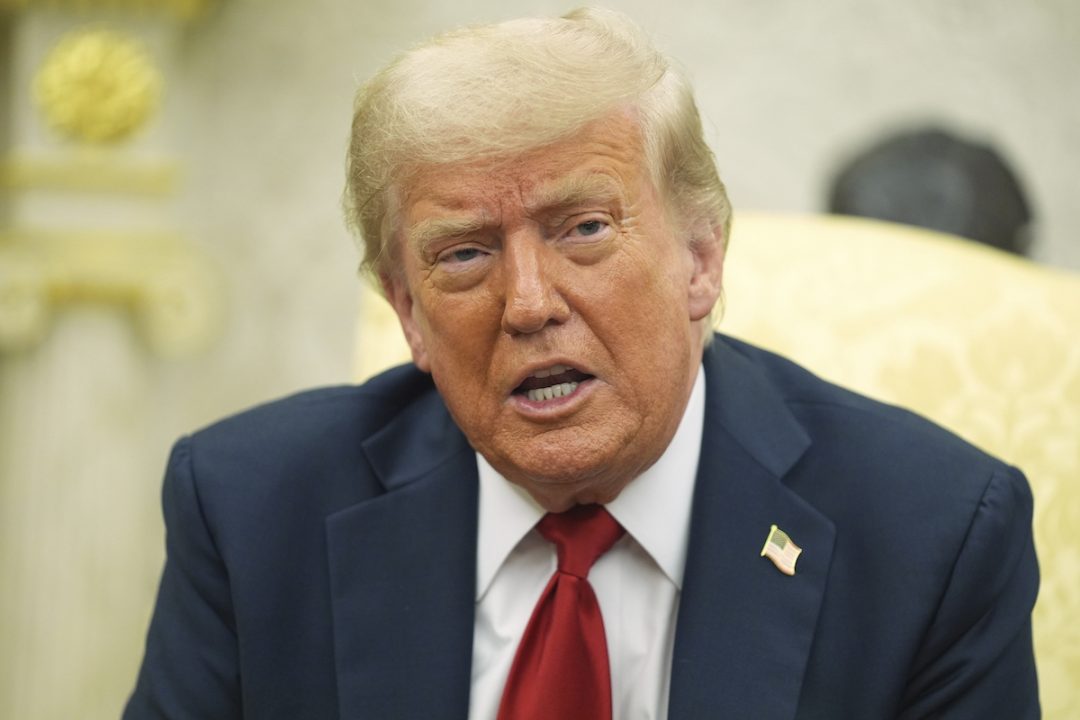
In an announcement during a Monday Oval Office meeting with North Atlantic Treaty Organization (NATO) Secretary General Mark Rutte, President Donald Trump gave Russian leaders 50 days to make peace with their neighbor or face “secondary tariffs” of 100 percent. In the meantime, the pipeline of American weapons to Ukraine will continue flowing.
Russia: Make a Deal or Face Tariffs
Trump said in the meeting:
We are very unhappy with Russia.… We’re going to be doing very severe tariffs if we don’t have a deal in 50 days.… We want to see [the war] end. And I’m disappointed in President [Vladimir] Putin because I thought we would’ve had a deal two months ago. But it doesn’t seem to get there.
Rutte could barely contain his glee at the president’s newfound willingness to pour more fuel on the Ukraine-Russia dumpster fire.
Trump said the tariffs he is considering would be “secondary tariffs,” which means they would be leveled against Russia’s trading partners, part of a strategy to further isolate Moscow from the global economy.
From America to NATO to Ukraine
Trump also announced an official weapons deal with NATO, which Rutte made clear will go toward arming Ukraine. “We’ve made a deal today where we are going to be sending them weapons and they’re going to be paying for them. We’re not buying it, but we will manufacture it, and they’re going to be paying for it,” Trump said Monday. Ukraine will be getting a shipment of as many as 17 Patriot missile systems soon.
The move was, of course, music to the ears of the neocon-dominated faction of Senate Republicans.
Frustrated With Putin
Trump has become increasingly frustrated with Russian leader Vladimir Putin over the last few weeks. He recently referred to their conversations as “meaningless.” On Monday, the president reiterated the reasons for his frustration, saying:
I speak to him a lot about getting this thing done. And I always hang up and say, “Well, that was a nice phone call.” And then missiles are launched into Kyiv or some other city. And after that happens three or four times, you say the talk doesn’t mean anything.
In the past Trump has failed to recognize Kremlin attacks that were responses to Ukrainian attacks deep within Russia. In late May, Russia launched a blistering barrage comprising hundreds of drone and missile strikes, including on the Ukrainian capital. Trump accused the Russians of attacking “for no reason whatsoever.” But prior to that attack, Ukraine had wreaked havoc within Russia over a span of five days, launching more than 700 drone strikes. Trump’s inability to acknowledge the retaliatory nature of the Russian strikes was astounding, given that even legacy media had published several reports corroborating the fact. The Russians had further accused Ukraine of hitting civilian infrastructure including bridges that same week.
Nevertheless, Western leaders who have wanted the U.S. to stay close to Ukraine and keep them in the fight have, for the time, prevailed.
Murky U.S. Strategy
The Russians, meanwhile, continue to maintain that they’re trying to resume peace negotiations with Ukraine. Russia’s Deputy Foreign Minister Mikhail Galuzin told state media organ Izvestia on Monday that “the Kremlin is currently awaiting signals from Kiev that would indicate a willingness to resume direct talks.” The problem, however, according to the Russians, is that Ukraine’s position is murky — and it’s murky because the United States can’t settle on a clear and consistent strategy.
Russian news agency TASS reported:
Ukraine’s next steps in the negotiation process cannot be assessed without taking into account the position of the United States, which remains Kiev’s primary ally, albeit not without reservations. Recently, Washington’s actions have appeared increasingly inconsistent. According to experts, the absence of a clear American stance further complicates the atmosphere ahead of a possible third round of negotiations.
TASS also quoted Russian political scientist Denis Denisov, who reiterated the absence of a clear and consistent strategy by the U.S. He said:
Russia’s position remains unchanged, as we can judge from official statements. Ukraine’s position also remains the same. But does the United States even have a coherent position? They give us no reason to believe that one exists. What we see is a collection of impulsive demands and slogans.
Trump’s critics in the U.S. have voiced similar complaints. The president can’t make up his mind whether Ukraine or Russia is harder to negotiate with. He can’t make up his mind whether Ukraine or Russia started the war. And he can’t make up his mind what role the U.S. will play. Months ago, he threatened to walk away from the negotiating process altogether and let them fight it out. And more recently, the administration diverted a shipment of anti-drone weaponry away from Ukraine, followed by the short pause of another weapons cache to Ukraine. But by Monday, not only had that weapons cache recommenced, but the administration had made it clear it will indirectly continue arming Ukraine.
Not Our Business
The noninterventionist position is that America has no business being involved in Eastern Europe at all. Neither Russia nor Ukraine poses a threat to the homeland. There is more to lose by proxy involvement than there is to gain. Moreover, the U.S. should exit NATO altogether, as it is destined to draw the U.S. into conflict.
Some experts on the matter argue that covert U.S. involvement triggered the war in the first place, specifically referring to America’s likely behind-the-scenes involvement in Ukraine’s 2014 Maidan Revolution. That event resulted in major changes to Ukraine’s government and its positions. Afterward, Ukraine began taking a number of steps toward NATO membership, a red line Russia has made known for decades. (You can read more about this in our reports here and here.)
During Monday’s meeting, Rutte made a comment that truly speaks to the situation. “In the end, you are the police agent of the whole world,” he said, referring to the United States. Trump didn’t even interrupt, much less push back.
The trouble with that is, a majority of Trump’s constituents don’t want America to be the world’s police force. That’s what the globalists want. In fact, it was Trump’s promises to put America first and discontinue policies that put the U.S. in the center of every major conflict in the world that appealed greatly to the millions of people who voted for him. But six months into the second Trump presidency, America’s decades-long foreign policy of playing global police remains unshaken.





